How Much Does It Cost to Install a Bathroom Fan?
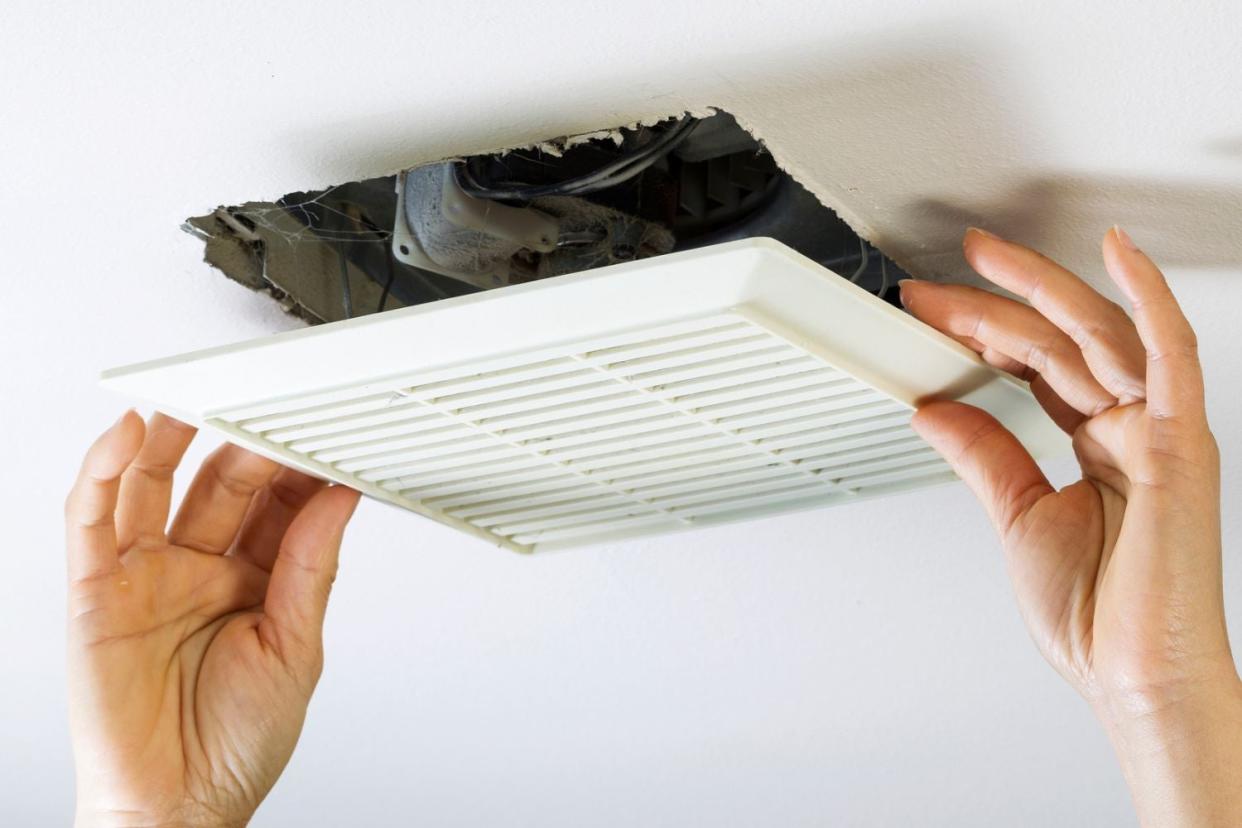
Highlights
The typical cost to install a bathroom fan ranges from $240 to $549, with a national average cost of $383.
The main factors that affect the cost to install a bathroom fan include the room size, number of fans, type of fan, noise level, installation location, labor, and geographic location.
A bathroom fan has many benefits, including better ventilation, reduced humidity, a lower risk of mold or mildew, and odor removal.
A handy homeowner may have the skills to install a bathroom fan themselves, but a professional may be better suited to complete this project, as it involves working with electricity.
In bathrooms, hot, moist air from the shower can cause a host of problems if it isn’t removed quickly. Humidity from the shower can cause mold and mildew growth, lead to peeling paint and warped shelving, and it can leave a lingering musty smell as well. In most cases, a bathroom exhaust fan is the most efficient and effective way to remove humidity and to prevent these issues from happening in the first place. An exhaust fan will also help to remove unwanted bathroom odors, keeping the room smelling fresh and clean. The cost to install a bathroom exhaust fan falls between $240 and $549, with the national average coming in at $384, according to Angi and HomeAdvisor.
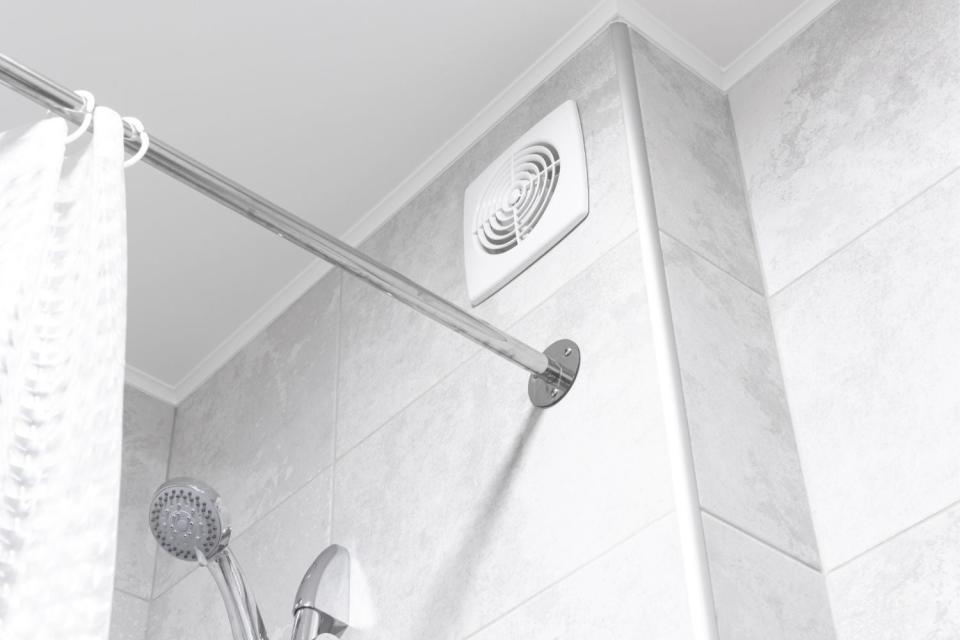
Photo: depositphotos.com
Factors in Calculating the Cost to Install a Bathroom Fan
While it may seem like bathroom fans are pretty straightforward, there’s actually more to them than meets the eye. Factors that can affect the cost to install a bathroom fan include the size of the room, labor costs, the external vent location, geographic location, and the fan itself, plus any special features it has.
Room Size
The size of the bathroom will dictate how many CFMs, or cubic feet per minute, that the bathroom fan will need in order to effectively remove humidity and odors. CFM measures how much air a fan can move, and a bathroom fan with higher CFMs can handle a larger space.
The square footage of the bathroom roughly equates to the bathroom fan size that is required to adequately remove moisture, humidity, and odors from the room. For instance, a bathroom fan with 40 to 70 CFMs can handle a 40- to 79-square-foot bathroom. A fan with this CFM range costs between $20 and $250. On the larger end of the spectrum, a bathroom that’s over 150 square feet would need a bathroom fan with over 150 CFMs or possibly more than one fan. A bathroom fan this size ranges in cost from $100 to $500.
Number of Bathroom Fans
A small bathroom, typically under 100 square feet, will likely need only one bathroom fan with CFMs that roughly equal the number of square feet. Bathrooms over 100 square feet may need more than one bathroom fan to handle the space.
In the case of a larger bathroom, strategically placing the bathroom fan should ensure that the space is adequately ventilated. Each fan should be about 50 CFMs, and when the total CFMs are added together, the number should be close to the number of square feet in the bathroom. While two or more bathroom fans may be needed, that doesn’t necessarily automatically double the cost. In some cases, two or more smaller, less expensive fans could be used rather than one with a higher number of CFMs, which may cost more.
Fan Type
Bathroom fan cost varies depending on the type of fan. There are three ways to mount a bathroom fan, and the cost is dependent not only on the fan type but also on the time it takes to install it along with the materials needed. Installation typically costs between $50 and $100 per hour for a qualified electrician.
Wall-mounted exhaust fans work well in first-floor bathrooms that don’t have easy access to the roof for ventilation. A wall-mounted fan is also a good option for a homeowner who wants to install a fan for a shower room or small bathroom. For a wall-mounted bathroom fan, the vent must go through the exterior wall or a soffit. The cost to install this type of fan depends on the thickness of the wall, the type of wall, and the amount of ductwork needed to reach the outside of the house. The cost to purchase a wall-mounted fan is between $130 and $340.
Ceiling-mounted exhaust fans typically vent through the roof via ductwork. Keeping the run of ductwork as short as possible or replacing a bathroom fan that has existing ductwork can keep the cost lower. Ceiling-mounted bathroom fans cost between $60 and $250.
Remote, or inline, exhaust fans have a fan integrated into a run of ductwork. The inline exhaust fan is typically installed in the ceiling cavity and pulls the air from the vent in the bathroom. Because the fan isn’t directly in the ceiling or wall, it can be quieter than wall- or ceiling-mounted versions. Remote bathroom fans cost between $100 and $300 but may be able to vent more than one bathroom.
Noise Level
Bathroom fans can be quite loud as they work to pull moisture and odors from the air. Bathroom ventilation fan noise is measured in sones. A noise level of 1 sone can be compared to the sound of rustling leaves, while 4 sones is comparable to the noise level in an office. For bathroom exhaust fans, the lower the sone level, the quieter the fan will be. The inverse is true for price. The lower the sone level, the higher the price will be, as shown in the following table.
Noise Level | Cost Range |
>1 sone | $150 to $350 |
1 sone | $100 to $200 |
2 sones | $40 to $90 |
3 sones | $30 to $60 |
4 sones | $20 to $50 |
Installation Location
Bathroom fans have two main jobs—to get rid of humidity and to get rid of odors. This means that bathroom fans are typically installed near the toilet and the shower and sometimes both if the bathroom is large or the toilet is separated from the rest of the bathroom. Whether the fan is mounted by the toilet or shower doesn’t affect the cost as much as how it is mounted. The cost to install a bathroom fan is between $50 and $100 per hour.
Bathroom exhaust fans can be ceiling-mounted, wall-mounted, or inline.
Ceiling-mounted fans cost between $20 and $500.
Wall-mounted fans cost between $30 and $240.
Inline fans cost between $100 and $300.
An electrician or HVAC technician can help the homeowner decide which type of fan would be most effective in their bathroom along with providing cost estimates for installation.
Labor
The cost of bathroom exhaust fan installation can vary widely depending on the amount of work and the level of difficulty. But who installs bathroom exhaust fans? Bathroom fan installation should be done by a professional electrician or HVAC technician who is well-versed in electrical wiring and HVAC systems, because the fan will need to be integrated into the ductwork as well as wired to electricity. Labor for an electrician to install a bathroom fan runs between $50 and $100 per hour.
"Need
"Maybe

+

"}" data-sheets-userformat="{"2":769,"3":{"1":0},"11":3,"12":0}">
Need a helping hand?
Get a pro to install a new bathroom fan. Get free, no-commitment project estimates from services near you.

+

Geographic Location
The cost to purchase and install a bathroom fan also varies by geographic location. The following table shows a few estimates for bathroom fan installation in different parts of the U.S.
City | Average Cost |
Birmingham, Alabama | $526 |
Boise, Idaho | $325 |
Chicago, Illinois | $200 to $550 |
Cleveland, Ohio | $344 |
Dallas, Texas | $150 to $450 |
Los Angeles, California | $250 to $550 |
New York City | $250 to $900 |
Philadelphia, Pennsylvania | $406 |
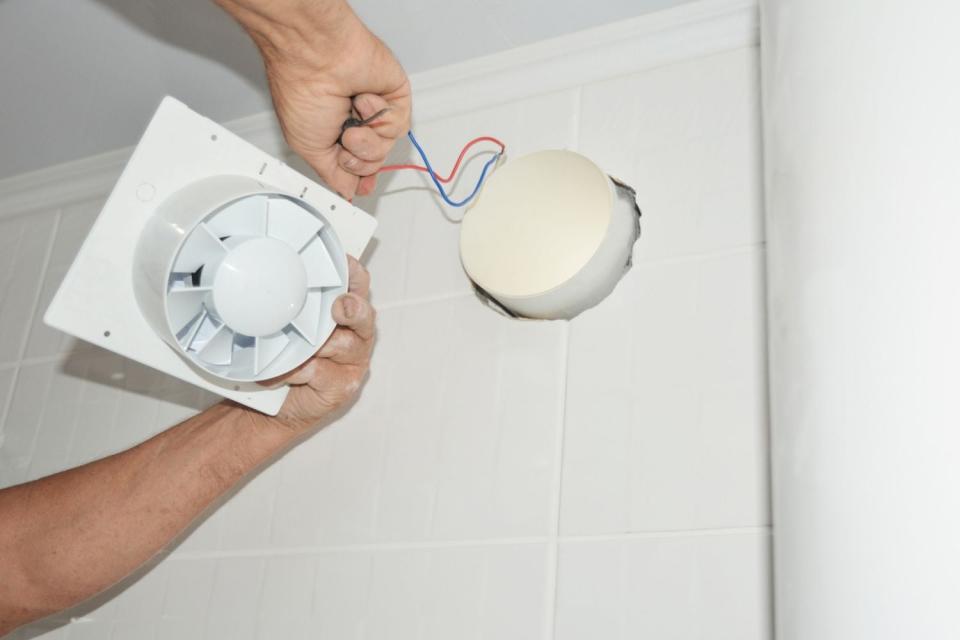
Photo: depositphotos.com
Additional Costs and Considerations
Additional costs and considerations that should be factored into the overall cost of a bathroom fan installation include whether the fan is new or a replacement fan, how much it costs to dispose of the old fan, whether any electrical and ductwork may need to be done, and whether the homeowner wants any special features.
New vs. Replacement Bathroom Fan
Installing a new fan will likely require more labor than replacing an existing fan. If the new fan is a different style or size than the existing fan, more labor may be necessary as well.
If the bathroom fan is replacing an existing fan, the homeowner will want to remove the existing fan and measure the hole size because that will guide the choice of the replacement fan. Bathroom fan replacement typically costs between $143 and $342 because the ductwork and electrical wiring are already in place.
If the fan is new, then the fan should be measured first and the hole should be cut to size. A new bathroom fan will require new wiring, and if ductwork is needed, it can significantly add to the overall cost. New ductwork can cost between $455 and $2,083 depending on the complexity of the project and the number of materials needed. If the project is part of a larger bathroom remodel cost, that can also affect the cost.
Old Fan Disposal
It may be tempting for the homeowner to just throw the old fan in the garbage and walk away, but depending on the condition of the fan and local recycling services, there may be a better way. If the fan is in good working order and is just being upgraded or replaced as part of a renovation, a local nonprofit organization such as Habitat for Humanity may be able to take it and reuse it. Other options are a local recycling center or transfer station where the homeowner can drop it off and have it screened to make sure it’s being disposed of properly. Depending on where it’s dropped off, there may be a small fee of around $10 to $20 to take care of disposal.
Electrical Work
If the fan is new, then an electrician may need to install the proper wiring. For replacement fans, the wiring should already be in place, which can decrease the overall cost. Electricians charge between $50 and $100 per hour for labor plus the cost of the materials. A typical bathroom exhaust fan installation takes between 2 and 4 hours for replacement fans.
Duct and Vent Installation
Much of the installation cost depends on how easily the ducts can reach the outside to properly vent air from the bathroom. The distance and complexity will dictate the number of materials that are needed as well as influence how long the job takes to complete.
Bathroom vent fans often vent through the attic via ductwork and out the roof or through the wall. The vent location will depend on what is more accessible and what makes the most sense in each specific job. In cases where the bathroom is located on an exterior wall, a wall-mounted bathroom fan that vents to the outside may make the most sense. In this case, the cost will depend on the thickness of the wall, the type of wall, and the amount of ductwork needed.
For ventilation through the roof, the cost will depend on how far the bathroom is from the roof. For instance, a first-floor bathroom exhaust fan may cost more to install than one on a higher floor because more materials are needed to reach the roof vent. If the new fan is replacing an existing fan, the cost will be significantly lower if new ductwork isn’t needed.
Duct installation can cost between $455 and $2,083, or about $10 to $25 per linear foot, so that will factor into the overall cost of the project.
Special Features
Older bathroom exhaust models were standalone units that loudly vented moist air from the bathroom. In some cases, they also included a light. Today’s bathroom exhaust fans range from the very basic models that just include the fans to models that include a host of features like bluetooth connectivity, a timer, humidity sensors, motion sensor, and adjustable speed. The following table shows how the most common special features can affect the total bathroom fan installation cost.
Feature | Average Cost |
Adjustable speed | $100 to $400 |
Automatic timer | $300 to $400 |
Basic fan | $20 to $80 |
Bluetooth | $100 to $300 |
Heater | $100 to $300 |
Humidity sensor | $100 to $400 |
Light | $40 to $400 |
Light and heater | $100 to $425 |
Motion sensor | $100 to $400 |
Timer | $100 to $300 |
Inspections and Permits
If the existing fan is being replaced, it may be a good idea for a homeowner to have the ductwork inspected and possibly cleaned by a professional. Mold inspection can cost an average of $648, and mold remediation can cost between $1,125 and $3439 when a homeowner hires one of the best mold removal companies.
If the project requires changes to the HVAC system, permits might be needed as well. HVAC permits cost between $250 and $400, but it’s important for the homeowner to check with the contractor and consult the local building code to be sure which, if any, permits are necessary.
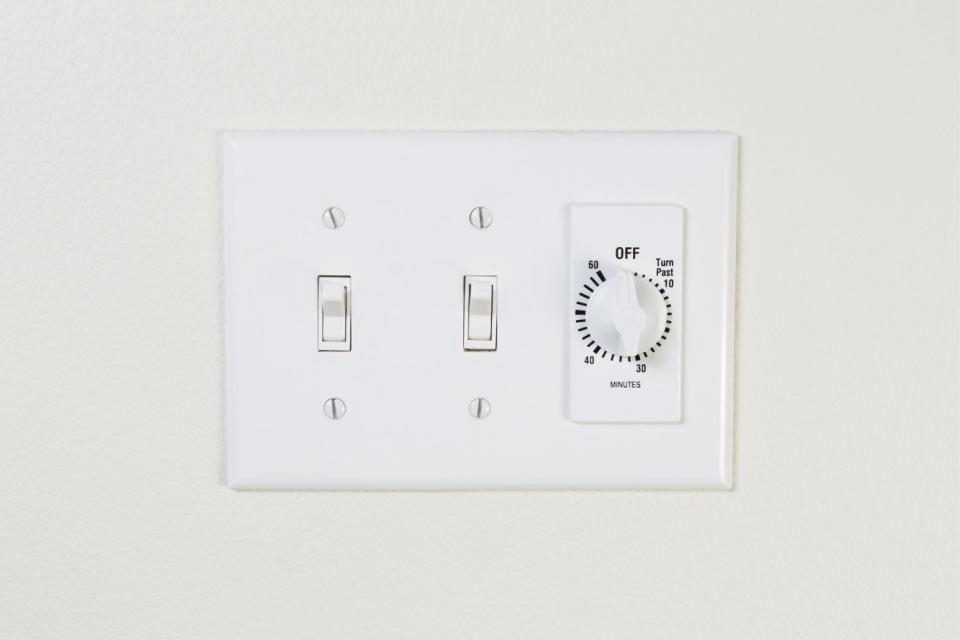
Photo: depositphotos.com
Types of Bathroom Fans
There are three main types of bathroom fans: ceiling-mounted, remote (also called inline), and wall-mounted. Each type is capable of pulling moisture, humidity, and odors from a bathroom, but their method of installation differs, and the choice may come down to the individual bathroom and the best path to vent air outside.
Type of Bathroom Fan | Average Cost |
Ceiling-mounted | $20 to $500 |
Remote, or inline | $100 to $300 |
Wall-mounted | $30 to $240 |
Ceiling-Mounted
A ceiling-mounted bathroom exhaust fan can vent through the ductwork and escape through roof vents, but it can also vent directly into the attic space. Because hot air and steam rise, bathroom ceiling fans work with the humidity’s natural tendency to pull it out of the bathroom, helping to reduce the amount of overall moisture buildup. Ceiling-mounted fans cost between $20 and $500.
Remote, or Inline
Remote, or inline, bathroom exhaust fans are positioned in the ceiling, and the ductwork is connected to a vent in the bathroom ceiling. This type of bathroom exhaust fan can be quieter than a wall-mounted or ceiling-mounted fan because the actual fan and motor are located in the ceiling. This is also a good choice when a bathroom needs two or more fans because they can be attached to the same exhaust fan. Inline fans cost between $100 and $300.
Wall-Mounted
A wall-mounted bathroom fan is a good solution in a small bathroom or one with tricky ductwork. Wall-mounted fans vent directly through the exterior wall to send unwanted heat and humidity out quickly. This style can be less expensive to install than ceiling-mounted and remote fans because less ductwork is required to access the exterior of the home. Other factors, like wall thickness and type, can affect the price, depending on how difficult installation is. Wall-mounted fans cost between $30 and $240.
Benefits of Installing a Bathroom Fan
In general, every bathroom can benefit from a ventilation fan. Bathroom fans are essential in removing the humidity that builds up in a bathroom as a result of a hot shower, and they offer other benefits as well. The humidity and moisture that a shower produces can settle onto surfaces that aren’t intended to be wet, including walls, cabinets, mirrors, shelves, and flooring. Once this moisture accumulates, it can have negative effects that include mold and mildew, peeling paint, and warped wood. Bathrooms can also be smelly places, and an exhaust fan helps to remove odors.
"Need
"Maybe

+

"}" data-sheets-userformat="{"2":769,"3":{"1":0},"11":3,"12":0}">
Need a helping hand?
Get a pro to install a new bathroom fan. Get free, no-commitment project estimates from services near you.

+

Improved Ventilation
Improved bathroom ventilation is the primary purpose of a bathroom exhaust vent. Appropriate ventilation will help to draw out humidity and odors from the bathroom. In bathrooms that contain a window, opening a window can have much the same effect as a bathroom exhaust fan, but in colder months, this isn’t an ideal solution.
Many building codes require an exhaust fan in bathrooms. The International Residential Code (IRC) requires that exhaust air from bathrooms and toilet rooms be exhausted directly to the outdoors and not recirculated within that residence.
Reduced Humidity
A bathroom fan draws moisture out of the air, reducing the humidity in the room. If left unchecked, humidity from a hot shower can create standing moisture on the bathroom’s surfaces. This humidity and moisture can create a number of issues that include, but aren’t limited to, mold and mildew growth, peeling paint, warped shelves, bubbled wallpaper, and damaged flooring. Reduced humidity can protect the bathroom from these issues, helping to avoid the need for costly repairs.
Lower Risk of Mold or Mildew
Reducing the humidity in the bathroom is essential to reducing the likelihood that mold and mildew will build up, leading not only to unsightly surfaces but also to the health effects that can come with the presence of mold and mildew, including asthma symptoms and shortness of breath for those with allergies, among other issues.
Odor Removal
While bathroom odors are often temporary, in bathrooms that don’t have an exhaust fan, the smell can linger and even build up over time until using the bathroom becomes unpleasant. And because most bathrooms are relatively small, odors can seem even worse. A bathroom exhaust fan can draw the odors out of the space and release them outside where they won’t bother anyone.
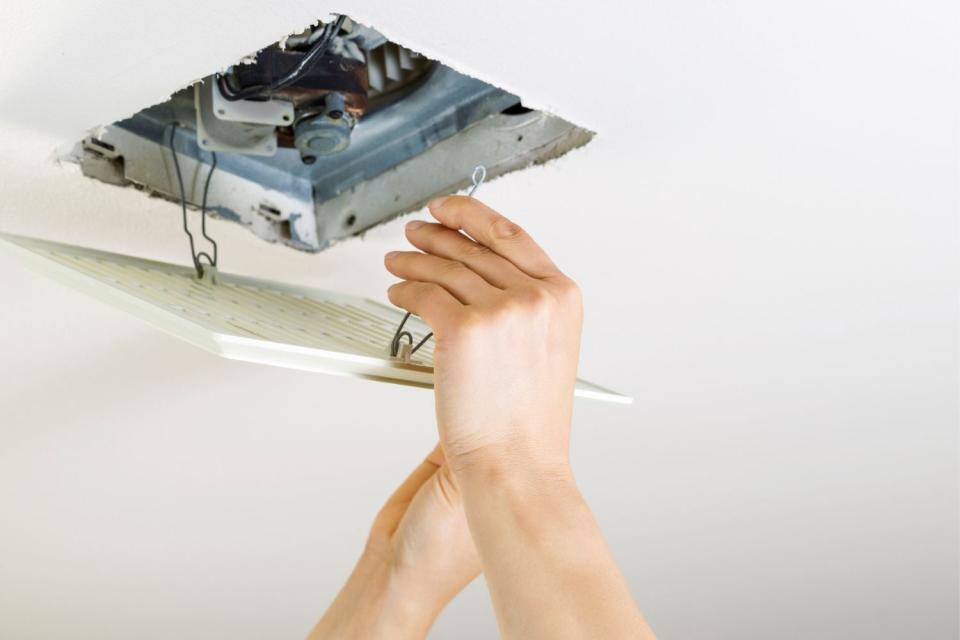
Photo: depositphotos.com
Bathroom Fan Installation: DIY vs. Hiring a Professional
When deciding between a DIY bathroom remodel vs. hiring a pro, homeowners will want to be aware that bathroom fan installation is deceptively difficult. Replacing a bathroom exhaust fan with a new one may sound like an easy weekend project for a homeowner, but it requires electrical and HVAC knowledge in order for the project to be completed successfully. Other factors include calculating the bathroom’s square footage and deciding on the appropriate number of CFMs that the bathroom fan should have. A professional will be able to determine the type and size of bathroom fan that will work best. In some cases, doing a DIY bathroom fan installation can cut down on labor costs and will likely run between $180 and $1,450—though it’s important for the homeowner to factor in the time it will take to install the fan, especially if this is an unfamiliar project.
For a DIY project of this type, there are a number of tools necessary to complete the work. While many of these are common household tools, others may not be as easily accessible and will need to be purchased, adding to the overall cost. Materials and tools include the following:
the fan itself
ducts
drywall saw
reciprocating saw
roof vent
roofing adhesive
roofing nails
ladder
other tools that depend on the specific job.
If the homeowner is installing a new bathroom fan, hiring an electrician or other professional is even more important because they will know the proper way to vent the bathroom fan to make it most effective, and they can also help select the appropriate fan type and size. Installing new electrical wiring and ductwork can be complicated and will require cutting a hole in either the roof or the exterior wall, which will then require appropriate seals to ensure they don’t leak. A professional will know how to install a bathroom fan properly so the homeowner can rest assured there won’t be any future issues.
"Need
"Maybe

+

"}" data-sheets-userformat="{"2":769,"3":{"1":0},"11":3,"12":0}">
Need a helping hand?
Get a pro to install a new bathroom fan. Get free, no-commitment project estimates from services near you.

+

How to Save Money on the Cost to Install a Bathroom Fan
When homeowners are deciding on the best bathroom fan that fits into their budget and foregoing some of the fancier features, doing some research can help save money on the cost to install a bathroom fan. Other money-saving tips include the following.
Opt for fewer CFMs. Choose the lowest CFMs possible that will still be able to handle the bathroom’s humidity.
Go with a cheaper mount option. Select a ceiling-mounted or wall-mounted fan for bathroom use.
Choose a basic model. A basic model with just the fan and a light will be cheaper than one with a special feature like bluetooth or a humidity sensor.
Research the options. Do the research and ask for quotes to find affordable though still well-qualified professionals.
Use the same installation location. Replace the existing fan rather than installing one in a new location.
Questions to Ask About Bathroom Fan Installation
Before hiring an electrician to install a bathroom fan, a homeowner can ask a few questions about the price and installation process to ensure the right person is hired for the job. Different electricians will likely provide different quotes, and because this person will be working in the home, it’s important that they are trustworthy and the homeowner feels comfortable around them. The following are a few questions to ask before hiring an electrician to install a bathroom fan.
Do you offer a written quote?
Can you provide me with references?
What is your experience with this type of work?
How long will the job take?
Do you handle all of the cleanup and disposal of materials?
What does your estimate include?
Do you offer a warranty?
Are you licensed and insured?
Will this job require a permit? Who handles permit applications?
How often do you install bathroom fans?
FAQs
From understanding CFMs and distinguishing between the different bathroom fan types to choosing from the wide range of special features, it’s no wonder that homeowners have questions when it comes to bathroom fan installation. The following are some frequently asked questions and answers to help homeowners fully understand this project.
Q. How do I replace a bathroom fan?
Replacing a bathroom fan is deceptively complicated. First, the homeowner will need to determine the size of the existing fan and the size of the hole that it sits in. Once they determine the correct size, they’ll need to select a fan, paying special attention to its CFMs and deciding which special features they want. Installing the fan requires knowledge of electrical wiring and HVAC systems and may require a permit depending on the local building codes.
Q. What size exhaust fan do I need for the bathroom?
An exhaust fan’s power is measured in cubic feet per minute (CFM). The higher the CFM, the more powerful the fan will be. A good rule of thumb is to get a fan with a CFM equal to the square footage of the bathroom. For instance, a 50 CFM fan should be able to handle the humidity and odors in a 50-square-foot bathroom.
Q. Is it hard to install a bathroom fan?
Removing an existing bathroom fan and installing a new one require knowledge of electrical wiring and the HVAC system in order to install it correctly. A new bathroom fan will require adding electrical wiring and ductwork, which can make an already complicated job even more difficult.
Q. Who installs bathroom exhaust fans?
An electrician should be the first person a homeowner contacts when they need to install a bathroom fan. Electricians can typically install one, but if not, they’ll be able to point the homeowner in the right direction. They may also work in conjunction with an HVAC professional to make sure everything is done correctly.
Q. How long do bathroom fans last on average?
A bathroom fan typically lasts for about 10 years. Its actual lifespan depends on how much it’s used and how hard it works to pull the humidity from the room. If the fan is louder than normal, doesn’t seem to be pulling out as much moisture and humidity as it used to, is letting odors linger, or is leaving more moisture on bathroom surfaces than normal, it may be time to replace the bathroom fan. A homeowner may be able to replace the bathroom fan motor, but this may cost the same as an entirely new unit.
Q. Is it OK to leave the bathroom fan running all the time?
Bathroom fans are intended to run in short bursts while the shower or toilet is being used. If a fan is left on for too long, it can pose a safety risk and become a fire safety hazard. Bathroom fans are designed to be used while a resident is in the shower and then left on for about 15 minutes afterward to allow it to remove as much humidity as possible.